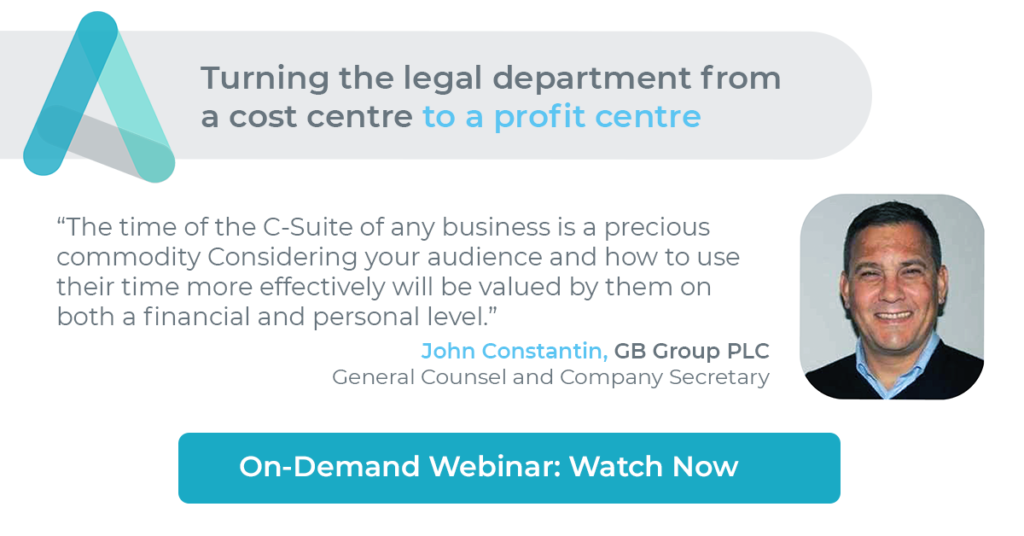One of the things we hear from clients all the time is that their external lawyers don’t understand them or their businesses.
It often creates a lot of friction that leads to negative outcomes.
I’ve often wondered what drives this disconnect.
I had the chance to speak to John Constantin, general counsel of GB Group and our discussion brought forward something I hadn’t thought of before.
(If you missed our chat click here to check it out.)

Most in-house lawyers train and work for many years in private practice.
The advice they provide to clients whilst there is the principal driver of profit and revenue at their firms. The more detailed and comprehensive that advice is, the better, as this directly leads to additional revenue. They then go in-house and this same approach is often an inhibitor of revenue and profit.
Too many times a fighting over legal minutia slows down a salesperson trying to close a contract.
The salesperson gets frustrated with the in-house team and the conflict raises the stress level across the organisation.
That behaviour suggests that a shift in approach is needed to drive the best outcomes for everyone.
Many people have spoken about this shift as moving the legal team from a cost centre to a profit centre. I think this misses the point.
Very, very few legal teams are ever going to be profitable in the traditional sense of bringing in more revenue than their costs.
(Yes, I’m sure there are some departments out there that can drive revenue from an IP litigation portfolio and I’m still waiting for a big department to do what Amazon did with its logistics business and effectively run an outsourced in-house function for other businesses, very happy to be proved wrong!)
I think a more attainable goal is to be a demonstrable profit enabler to the business. It’s also a lot easier to get credit for.
John from GB Group shared a couple of ways that he achieved this which I think are worth unpicking:
Know your customer – As an in-house team it’s critical to know who you’re serving and what they want. 3 ideas for doing this:
- Embed the in-house team with the business. It doesn’t have to be forever or imply that only a decentralised team can work. Just getting to know the nuts and bolts of what the business does will pay dividends down the road. It also helps to build confidence that the legal team isn’t in some ivory tower but rather they’re real people trying to help out in the best way possible.
- Understand your customers needs in detail. This starts with asking. Basic tools like Survey Monkey can be a great start. Is speed to contract important to your sales teams? Are minimising changes to documents going to help out your procurement team? You can then measure yourself against these objectives and create some KPIs.
- Think about how to change your service delivery based on what you’re hearing. As an example, to lawyers, red lines are natural constructs. To a sales person who has to look through a 100-page document and try to understand what they need to go back to the client on, they can be a nightmare. Try starting with an issues list instead that lays out the big things that need addressing. It’s a much different mindset with customers if you’re ‘agreed in principle’ and you’re just fine-tuning, versus trying to work through 100 small changes that feel equally important.
Understand how you’re doing – it’s not enough to be able to think you’re doing a good job, it’s critical to know how you’re doing it. KPIs and data are key to doing this and they should be based on what you’ve learned about serving your customers above. If speed to contract is key are you tracking where each contract is? What’s legal’s turn around time? Tracking these KPIs doesn’t have to be complicated, an Excel sheet can do as a start.
Switch the mindset – changing how the legal department is perceived is critical to both reducing friction and getting the resources and team needed to be effective:
- External – helping stakeholders see the value of legal builds trust and demonstrates value. One easy win is to report back to the business at large on the KPIs you think are important to them. If the business thinks that legal turn around times are problematic, measure them and report over time about how they’ve fallen. Combine this with collecting feedback from the business and you’ll soon create a cycle where you’re rewarded for improvement and the broader team believes you are aligned and they are being listened to.
- Internal – changing the attitudes of the in-house team are just as important as those externally. Key to this is learning to take a risk based approach to a given problem. A customer who’s been with the business for 20 years and has always paid on time probably doesn’t require the same level of liability protection than a brand-new customer who’s unknown or has a much lower credit score.
When these three pieces come together they paint legal in a new and better light within the organisation. They have the added benefit of generating leverage for the team.
Want that shiny new piece of legal tech or that additional full time team member? It’s a lot easier to make that case if you can tell your CFO that you’ve listened to the business and that this would address their needs by specifically improving these KPIs.
CFOs are far more likely to listen to that argument versus just continuing to add costs that are a drag on profit, or worse actively slow things down.
The gulf between private practice and in-house success doesn’t have to persist.
Become the profit enabler your business deserves.
Build a bridge,
Christopher Thurn
Founder – Alacrity Law

